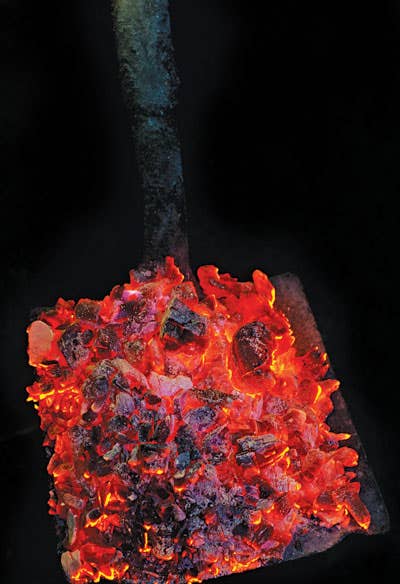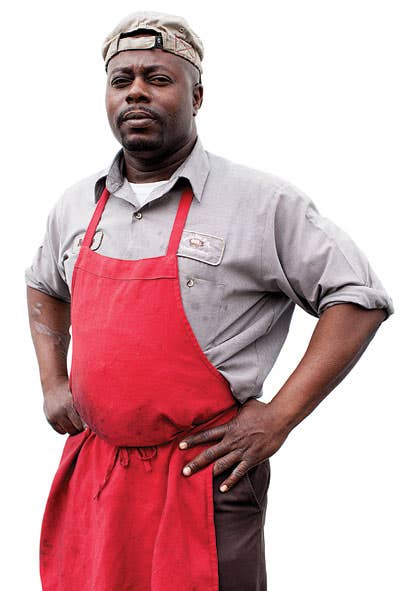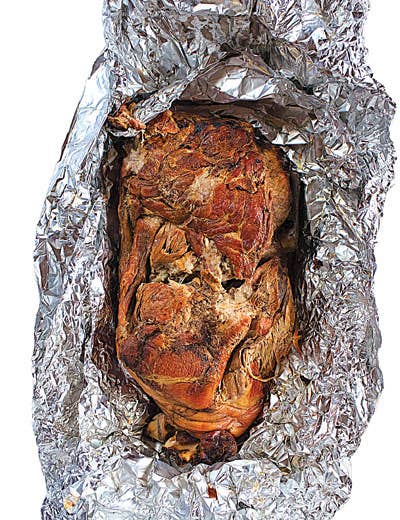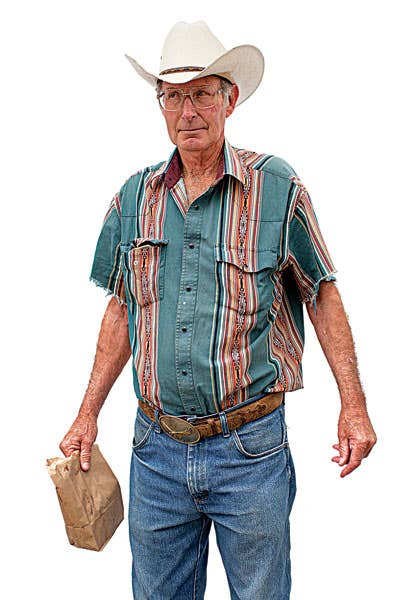
All across America, the men and women of barbecue are preserving a culinary art form
I grew up in central Georgia, near Macon, one-half mile from Old Clinton Barbecue, a tin-roofed, sawdust-floored roadhouse shrouded in hickory smoke. Mittie Coulter, mother of proprietor Wayne Coulter, worked the chopping block. By the time my Schwinn hit the gravel parking lot, I could hear the measured and percussive thwack of her cleaver. It carried through the dining room, past Wayne's collection of antique cash registers, as she hacked fat and skin from hams, chopped the flesh to smoky bits, and doused it all with a thin, ketchup-tinged sauce that tasted of cider vinegar and red pepper.
I can see the granny glasses Mrs. Coulter wore. I can see that cleaver, too, spangling beneath the overhead fluorescent lamp. But I can't picture the black men who worked for her, tending the massive pit out back, shoveling hardwood coals beneath those hams. From the time I was two until I left for college, at 17, I ate the food those pitmasters cooked. But their stories are lost to me. I don't know their last names. I don't even know their first names.
A good measure of my work with the Southern Foodways Alliance—a University of Mississippi—based nonprofit that documents, studies, and celebrates the diverse food cultures of the changing American South—has been an attempt to pay down a debt of pleasure owed to those unnamed pitmasters, to honor their labor, to frame their life experiences so that a broad swath of Americans may recognize barbecue as a great national food and pitmasters as unsung culinary and cultural heroes.
Not all of the stories are lost, of course. Titans of barbecue, with strong tethers to the past, still walk among us. I was reminded of this on a recent swing through the heartland of barbecue culture, to visit some of the men and women whose work has long inspired me. Talking with these pitmasters as they cooked, and meeting their families and their customers, I realized that their life stories evoke larger-picture American stories, ones that touch on race, class, gender, labor, change, and continuity.
James Jones, in the Arkansas Delta town of Marianna, is one pitmaster I'll always go out of my way to visit. The 66-year-old oversees the hip-high cinder-block pits at Jones Bar-B-Que Diner, carrying on a family tradition that began in the early 20th century. Jones's father, Hubert Jones, recalled in a 1986 interview that the family's initial barbecue apparatus was "a hole in the ground, some iron pipes, and a piece of fence wire and two pieces of tin."
"My father would sell the meat in town at this place they had. They called it the Hole in the Wall," James Jones told me as we stood in the two-story shotgun building that houses the cooking pits for his wood-smoked pork shoulder. He constructed a sandwich of tender hacked pork on flimsy white bread and handed it to me. It was outstanding. "That's what it was. Just a window in a wall where they sold meat from a washtub."

Credit: Landon Nordeman
Rodney Scott, pitmaster of Scott's Bar-B-Que in Hemingway, South Carolina
Jones's story is similar to many I've heard from pitmasters around the South: For their ancestors, barbecue was an opportunity—a way to leverage equity and muscle to build successful businesses. By the late 1930s, as new roads stretched across the South and community barbecue traditions begat city commerce, young entrepreneurs began selling sandwiches from roadside shebangs. And in a leap that would give a lexicographer whiplash, a vocation that had been built largely on the labor of enslaved African-Americans began referring to its best practitioners as pitmasters.
Though the first known mention of the word pitmaster as it relates to barbecue dates to 1939, in a North Carolina newspaper, recognition of the vocation preceded common usage of the term by a half-century or more. At the close of the 19th century, sheriff John W. Callaway of Wilkes County, Georgia, earned a reputation as a "presiding genius at the pits" and "the patron saint of barbecue." Like many white men of his day, he didn't actually shovel coal and smoke hogs; for the dozens of barbecues he supervised each year, he relied on the labor of African-Americans like Henry Pettus, described in reports as his "right hand man."
Race has always been a subtext of barbecue. In much of the South, blacks traditionally did the pit-cooking while whites supervised. A series of photographs taken in 1944 at Thomas Pearsall's annual barbecue near Rocky Mount, North Carolina, illustrates a typical scene. The cook shed was wood-beamed. The shallow pits, overlaid with gut-splayed pigs, were earthen. The captions, supplied by the photographer, set the tone: "Unidentified black cook oversees the barbecuing pigs." And "Black cook bastes barbecuing pigs." And "Unidentified black elder spoons basting sauce over barbecuing pig."
This is not to say that all great pitmasters have been black. In the upper reaches of the South, early photographs also showed working-class white men with their hands on those long-handled shovels used to guide payloads of hickory coals to the pits. The point is that barbecue, when done well, is arduous, and most pitmasters, white and black, have been working-class folks. That was the case historically. That's still the case today.
Ricky Parker, proprietor of Scott's-Parker's barbecue, a low-slung joint on the fringe of Lexington, Tennessee, is, to my mind, a poster child for the kind of labor that pitmasters endure. A gangly white man who seems to always keep an unlit cigarillo clenched in his teeth, Parker works 16 to 20 hour days, six days a week, cooking whole hogs over hickory coals for the kind of devoted customers who appreciate the textural differences between ropy belly and fat-threaded shoulder meat.
This work ethic is in Parker's bones. As a boy, he shuttled between Florida and Michigan with his family, following the crop seasons, getting up at dawn to pick oranges or apples before school. In 1976, Parker quit high school to work for Early Scott, a pit-master in Lexington who would become his adopted father. The labor of barbecue proved a comparative relief.

Credit: Landon Nordeman
Helen's pork shoulder
Parker has worked those pits ever since, and he can tell when a whole hog is done just by the feel of its flesh beneath its burnished skin. It's a skill he's taught his sons, Matthew, 20, and Zachary, 21, who work with him. On my most recent visit to Scott's-Parker's, the boys gave me a tour of their new screened-in pit room. And as they shoveled hickory embers, they told me that they intend to carry on the business when their father steps out of the smoke.
Much of the dialogue about barbecue focuses on tradition and intransigence. This kind of cooking is not only hard work; it's a learned art. Yet barbecue, like all products of culture, is not static. It evolves.
Helen Turner, proprietor of Helen's Bar-B-Que, a six-seat cafe set in a prefab metal shed in Brownsville, Tennessee, is a case in point. Female barbecue cooks were once few, but today women like Turner take their place among the masters of the pit. "It's kind of bad on my eyes sometimes," she said, referring to the wood smoke that clouds the pit room at the rear of her restaurant. "I cry every once in a while, but that's just how I make my living, so I just go ahead on." Instead of whole hogs, which would be harder to move around the pit, Turner works with shoulders. And though her husband, Reggie, helps out, the business is hers. And so is the pride she takes in her sandwiches, piled with smoke-blackened outside meat, capped with sweet slaw, and drenched in a cayenne-spiked sauce. My son, Jess, age 10, who visited Helen with me this spring, declared that sandwich to be his favorite taste of the past year.
As I've traveled across the South, I've noticed other ways in which the world of barbecue is evolving. Many traditional pitmasters grapple with the economics of barbecue labor, as well as with the allure of more efficient fuels like manufactured charcoal and gas.
"This way of life is disappearing," Steve Grady told me when I visited him a few months ago. He and his wife, Gerri, own Grady's Bar-B-Q, set in a small compound of buildings south of Goldsboro, North Carolina. "People used to farm, and we used to feed them. Now folks are getting out of tobacco," Grady said, referring to the region's former leading crop. As he sat at a plywood booth inside the family's shoe-box dining room, he faced down a foam tray loaded with his hashed and vinegared whole hog, creamy slaw, and fried corn sticks. "And it's tougher to get the good pigs I need for good barbecue."

Credit: Landon Nordeman
A customer at Jones Bar-B-Que Diner
Like any old-timer worthy of his sauce, Grady has long believed that barbecue is a marriage of pork and wood. But over the last four or five years, he's adapted his process a bit. He now starts his fire with bags of commercial charcoal—a shortcut—and finishes cooking with wood.
Another development that has sparked change among pitmasters—if not in the way they cook, then in how they approach their work—is that barbecue has gentrified. As diners with no baseline experience with slow-smoked meats have come to appreciate them as one of America's great indigenous foods, a new profile has emerged: the celebrity pitmaster.
One of our nation's reigning advocates for barbecue is a gregarious 65-year-old named Ed Mitchell. He learned his trade in Wilson, North Carolina, in the 1960s, and now showcases his talents at the Pit, a comparatively high-toned restaurant in nearby Raleigh, which serves dishes like french fries topped with pimento cheese, and barbecued tofu. But whole hog, smoked and sauced in the vinegar-seasoned style of eastern North Carolina, is still Mitchell's signature dish.
Mitchell, who studied sociology in college, has fully embraced the pitmaster persona. He travels to barbecue events with an 18-wheeler full of equipment, emblazoned with a larger-than-life self-portrait, bordered in flames and topped by the bold legend #1 pitmaster. When we see each other at events like the Big Apple Barbecue Block Party, where dozens of pitmasters gather in New York City's Madison Square Park, he tugs on the straps of his overalls, smiles big, and, on occasion, sneaks me strips of pork skin, crisp from the fire.
To my mind, though, no pitmaster has better translated his craft for 21st-century audiences than Rodney Scott, of Scott's Bar-B-Que in rural Hemingway, South Carolina. Scott, who is 39, was born to this work. He cooked his first hog when he was 11. In the ensuing years, he has claimed his family's tin-roofed country store as his perch. He's a traditionalist who sources his pigs from local farmers, makes his own charcoal, and cooks those pigs in masonry pits. But unlike many pitmasters of the past, he knows the value of his labor. Sitting beneath the low eaves of the store, on a deconsecrated church pew, I revel in the excellence of his output: creamy tangles of tender pig that smell of wood fire and time immemorial. And I recall his words.
"Every week we go out, get the old truck started, and get the chain saws together to go get what we need to put the flavor in what we do," Scott said in my friend Joe York's 2010 film about barbecue culture, Cut/Chop/Cook. "Kind of like a chef going to pick his tomatoes in the garden, I go pick my trees out of the woods."Every time I see Scott—and despite the distance from Mississippi, where I live, to South Carolina, I see him four to six times a year—he says something to that effect. Cynics might say he's become less of a barbecue man and more of a marketer. I'd say they're flat wrong. Like many a pitmaster in this American moment, when barbecue is hip and pitmasters are, arguably, more relevant than many white-tablecloth chefs, he's earned his moment to speak. And he speaks well of the future of barbecue.
Keep Reading
Continue to Next Story










